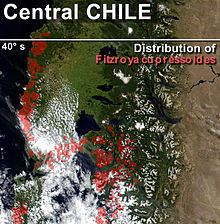
The Huilliche, Huiliche or Huilliche-Mapuche are the southern partiality of the Mapuche macroethnic group in Chile and Argentina. Located in the Zona Sur, they inhabit both Futahuillimapu and, as the Cunco or Veliche subgroup, the northern half of Chiloé Island. The Huilliche are the principal indigenous people of those regions. According to Ricardo E. Latcham the term Huilliche started to be used in Spanish after the second founding of Valdivia in 1645, adopting the usage of the Mapuches of Araucanía for the southern Mapuche tribes. Huilliche means 'southerners' A genetic study showed significant affinities between Huilliches and indigenous peoples east of the Andes, which suggests but does not prove a partial origin in present-day Argentina.

The Valdivian temperate forests (NT0404) is an ecoregion on the west coast of southern South America, in Chile and Argentina. It is part of the Neotropical realm. The forests are named after the city of Valdivia. The Valdivian temperate rainforests are characterized by their dense understories of bamboos, ferns, and for being mostly dominated by evergreen angiosperm trees with some deciduous specimens, though conifer trees are also common.
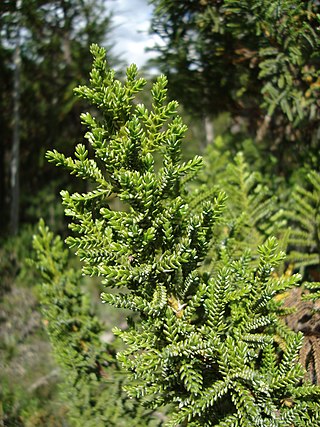
Pilgerodendron is a genus of conifer belonging to the cypress family Cupressaceae. It has only one species, Pilgerodendron uviferum, which is endemic to the Valdivian temperate rain forests and Magellanic subpolar forests of southern Chile and southwestern Argentina. It grows from 40 to 54°20' S in Tierra del Fuego, where it is the southernmost conifer in the world. It is a member of subfamily Callitroideae, a group of distinct Southern Hemisphere genera associated with the Antarctic flora.

Nothofagus dombeyi, Dombey's beech, coigue, coihue or coigüe is a tree species native to southern Chile and the Andean parts of Argentine Patagonia. It is a fast-growing species that can live in a wide range of climatic conditions, and forms dense forests. It is cultivated for its timber, and as an ornamental subject.

Chiloé National Park is a national park of Chile, located in the western coast of Chiloé Island, in Los Lagos Region. It encompasses an area of 430.57 km2 (166 sq mi) divided into two main sectors: the smallest, called Chepu, is in the commune of Ancud, whereas the rest, called Anay, is in the communes of Dalcahue, Castro and Chonchi. The greater portion of the Park is in the foothills of Chilean Coastal Range, known as the Cordillera del Piuchén. It includes zones of dunes, Valdivian temperate rain forests, swamps, and peat bogs. A small portion, Metalqui, is an islet with an area of 0.5 km2 (0.19 sq mi). It is located between 42° 07' and 42° 13' south latitude and between 73° 55' and 74° 09' west longitude.

Zona Sur is one of the five natural regions on which CORFO divided continental Chile in 1950. Its northern border is formed by the Bío-Bío River, which separates it from the Central Chile Zone. The Southern Zone borders the Pacific Ocean to the west, and to the east lies the Andean mountains and Argentina. Its southern border is the Chacao Channel, which forms the boundary with the Austral Zone. While the Chiloé Archipelago belongs geographically to the Austral Zone in terms of culture and history, it lies closer to the Southern Zone.

Valdivian Coastal Reserve is a natural reserve located in the Cordillera Pelada, in Los Ríos Region of Chile, near Corral.
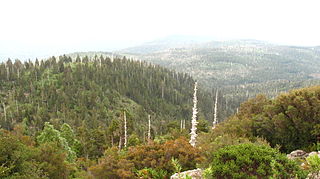
Alerce Costero National Park is a protected wild area in the Cordillera Pelada about 137 km from Valdivia and 49 km from La Unión. Fitzroya trees grow inside the protected area and give the area its name, with Alerce Costero translating as Coastal Fitzroya. The Natural Monument has a total area of 137 hectares.

The Chiloé Archipelago is a group of islands lying off the coast of Chile, in the Los Lagos Region. It is separated from mainland Chile by the Chacao Channel in the north, the Sea of Chiloé in the east and the Gulf of Corcovado in the southeast. All islands except the Desertores Islands form Chiloé Province. The main island is Chiloé Island. Of roughly rectangular shape, the southwestern half of this island is a wilderness of contiguous forests, wetlands and, in some places, mountains. The landscape of the northeastern sectors of Chiloé Island and the islands to the east is dominated by rolling hills, with a mosaic of pastures, forests and cultivated fields.

Alsodes valdiviensis is a species of frogs in the family Alsodidae. It is endemic to Chile and only known from its type locality, Cerro Mirador in the Cordillera Pelada, Valdivia Province. The specific name refers to this province.
Batrachyla fitzroya is a species of frog in the family Batrachylidae. It is endemic to Argentina and only known from its type locality, Isla Grande in Lake Menéndez, in the Los Alerces National Park, Chubut Province. The specific name fitzroya refers to Fitzroya cupressoides, a prominent tree at the type locality.

Nothofagus nitida is an evergreen tree, native to southern Chile and Argentina. It is found from latitude 40° S to Última Esperanza.
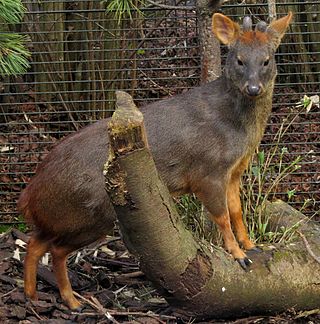
The southern pudu is a species of South American deer native to the Valdivian temperate forests of south-central Chile and adjacent Argentina. It is classified as Near Threatened in the IUCN Red List.

Cordillera Pelada is a mountain range in southern Los Ríos Region, southern Chile. It is located along the Pacific coast and forms part of the larger Chilean Coast Range. It got its name pelada from the Spanish word for bare or bald in reference to large fires that once burned the forests on the cordillera.
Alerce is the Spanish word for two unrelated trees Larix (larch) and Fitzroya, albeit the name was first applied to the larch.
Bosques Templados LLuviosos de los Andes Australes is a Biosphere Reserve in southern Chile. It was declared a Biosphere Reserve by UNESCO in 2007. The reserve protects a large portion of the Valdivian temperate rain forest ecoregion. At least three tree species found in the reserve are listed by CITES as threatened, namely Fitzroya cupressoides, Araucaria araucana and Pilgerodendron uviferum.
From 1850 to 1875, some 30,000 German immigrants settled in the region around Valdivia, Osorno and Llanquihue in Southern Chile as part of a state-led colonization scheme. Some of these immigrants had left Europe in the aftermath of the German revolutions of 1848–49. They brought skills and assets as artisans, farmers and merchants to Chile, contributing to the nascent country's economic and industrial development.
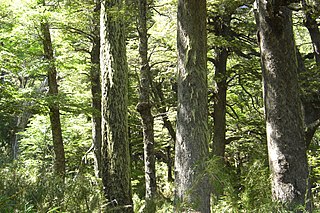
Bosque Andino Patagónico, also known as Patagonian Andean forest, is a type of temperate to cold forest located in southern Chile and western Patagonia in Argentina at the southern end of South America. The climate here is influenced by humid air masses moving in from the Pacific Ocean which lose most of their moisture as they rise over the Andes. The flora is dominated by trees, usually of the genus Nothofagus.

The last glacial period and its associated glaciation is known in southern Chile as the Llanquihue glaciation. Its type area lies west of Llanquihue Lake where various drifts or end moraine systems belonging to the last glacial period have been identified. The glaciation is the last episode of existence of the Patagonian Ice Sheet. Around Nahuel Huapi Lake the equivalent glaciation is known as the Nahuel Huapi Drift.

Agriculture in Chile has a long history dating back to the Pre-Hispanic period. Indigenous peoples practised varying types of agriculture, from the oases of the Atacama Desert to as far south as the Guaitecas Archipelago. Potato was the staple food in the populous Mapuche lands. Llama and chilihueque herding was practised by various indigenous groups.
[Chile] is rich in pastures and cultivated fields, in which all kind of animals and plants can be breed or grown, there is plenty of very beautiful wood for making houses, and plenty of firewood, and rich gold mines, and all land is full of them...

